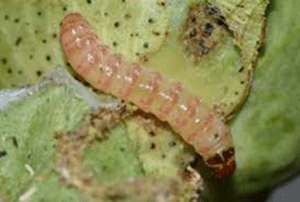TAG: GS 3: SCIENCE AND TECHNOLOGY, AGRICULTURE
THE CONTEXT: A pilot project led by the Central Institute for Cotton Research (CICR), under the Indian Council of Agricultural Research (ICAR), is leveraging artificial intelligence (AI) to combat the pink bollworm (PBW) infestations that have plagued cotton farmers in Punjab.
EXPLANATION:
- This innovative approach aims to provide real-time pest monitoring and timely interventions to reduce the economic losses from this devastating pest.
- Cotton farmers have experienced significant economic hardship over the past three years due to severe PBW infestations on their cotton fields.
- However, this year, one of the farmers was selected for the CICR’s groundbreaking pilot project that utilizes AI for pest control.
Project Implementation and Scope
- The pilot program focuses on three major cotton-growing districts in Punjab: Muktsar, Bhatinda, and Mansa.
- Six fields from each district have been selected, making a total of 18 fields.
- If successful, the project will be extended to Rajasthan and Haryana.
- The use of AI-powered pheromone traps marks a pioneering effort in India to deploy AI in pest control for any crop.
- This initiative aims to empower farmers with accurate, real-time information to make timely pest management decisions, significantly reducing the economic impact of PBW infestations.
The Threat of Pink Bollworm
- The pink bollworm (Pectinophora gossypiella) is a significant pest that destroys parts of the developing cotton fruit, including the square (flower bud) and the boll (seed sac with cotton fibers.
- This pest has severely affected cotton crops in northern Indian states, including Punjab, Haryana, and Rajasthan, even impacting the genetically modified pest-resistant Bt Cotton (Bollgard II seed).
- On average, PBW infestations cause at least a 20-25 percent yield loss, posing a serious threat to cotton farmers’ livelihoods.
How the New Technology Works
- Traditional pheromone traps containing the pheromone gossyplure have been used to attract and reduce crop pests by monitoring male moth activity.
- However, farmers often find monitoring these traps challenging, especially when managing multiple crops.
- In the new digital approach, AI-powered pheromone traps equipped with cameras take regular pictures of the moths attracted by the pheromones.
- These images are transmitted in real-time to a remote server in the cloud.
- A machine learning algorithm trained to identify and count PBWs analyzes the images.
- The results are accessible to ICAR scientists, farmers, and agriculture extension officers via a mobile app that provides real-time pest alert information.
Benefits of the AI System
- This AI-driven system addresses several challenges faced by farmers:
- Real-Time Monitoring: Farmers receive hourly updates on pest activity, enabling timely interventions.
- Accurate Pest Management: The system provides precise data on pest populations, helping farmers to take appropriate pest control measures before the infestation reaches the economic threshold level (ETL).
- Reduced Labor: The automated monitoring system reduces the need for farmers to manually check traps daily, allowing them to focus on other agricultural activities.
Role of Agricultural Authorities
- The data collected from these AI-powered traps will also be shared with state agriculture department officials, taluka officials, and village-level extension functionaries.
- This information will be used to create mass campaigns and advisories, ensuring that a more significant number of farmers can benefit from timely pest management insights.
Future Prospects
- If the pilot project in Punjab proves successful, the CICR plans to implement the AI-driven pest monitoring system in other cotton-growing states, such as Rajasthan and Haryana.
- This could herald a new era of precision agriculture, where technology plays a pivotal role in safeguarding crops and farmers’ livelihoods.
PINK BOLLWORM:
- It is a major pest of cotton, causing significant yield losses worldwide.
- It is originally native to India but now it is recorded in nearly all the cotton-growing countries of the world.
- The larvae of the pink bollworm bore into cotton bolls, feeding on the developing seeds. This can result in significant yield losses and reduced seed quality.
- It is one of the most destructive pests of cotton.
- Pectinophora gossypiella is its scientific name.

- The adults are small moths about 3/8 inch long and are dark brown with markings on the fore wing.
- The larval stage is the destructive and identifiable stage.
- The larvae have distinctive pink bands and can reach a length of ½ inches right before they pupate.
ECOLOGICAL THREAT:
- Pink bollworms are significant pests of cotton.
- Adults only last for 2 weeks, but females will lay 200 or more eggs.
- Adults lay eggs on cotton bolls; once hatched, the larvae eat the seeds and damage the cotton’s fibers, reducing yield and quality.
- When the larvae mature, they cut out the boll and drop to the ground and cocoon near the soil surface.
- It has also been observed to attack hibiscus, okra, and hollyhock plants.
BT COTTON:
- Bt cotton has been genetically modified by the insertion of one or more genes from a common soil bacterium, Bacillus thuringiensis.
- These genes encode the production of insecticidal proteins, and thus, genetically transformed plants produce one or more toxins as they grow.
- The genes inserted into cotton produce toxins that are limited in activity almost exclusively to caterpillar pests (Lepidoptera).
- However, other Bacillus thuringiensis strains have genes that encode toxins with insecticidal activity on some beetles (Coleoptera) and flies (Diptera).
- Some of these genes are used to control pests in other crops, such as corn.
BENEFITS OF BT COTTON:
- Increased yields
- Reduced insecticide use
- Improved fiber quality
- Reduced environmental impact
- Increased farmer income

